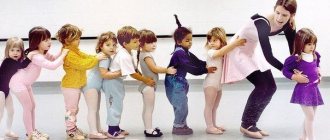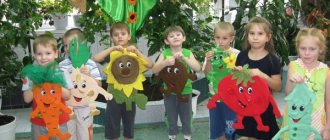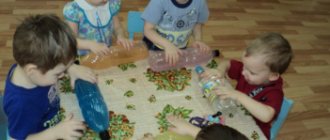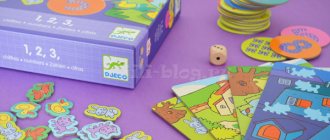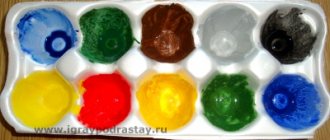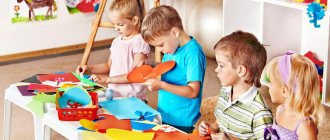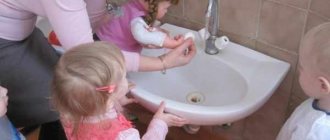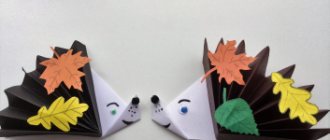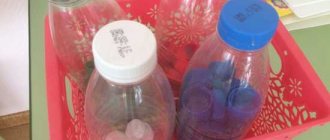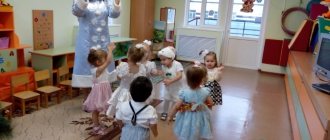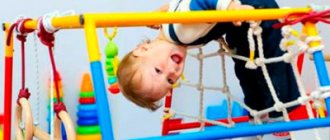Round dance games in the activities of preschoolers: features and significance
Currently, there is great attention to national culture and art. The spiritual and moral education of the younger generation is carried out through the constant study of folklore, folk crafts and traditions. Round dance games have gained popularity in working with preschoolers for a reason. Round dance is the oldest type of dance. He accompanied the Slavs in various life situations: during ritual processions, field work, wedding festivities, etc.
Russian round dance has long been not just a dance, it is a way of life
How do round dance games benefit children's development?
- The very formation of a round dance - a circle - educates the children. Placing participants at equal distances from the center creates a feeling of equality. In a round dance chain, each child understands the importance of moving to the beat of the music, in accordance with the rules. Everyone is responsible for the integrity of the round dance; this game helps to organize the group.
- Round dance games are musical and rhythmic. Children move in a circle and make additional movements to the beat of the music. Sound perception and coordination of movements develops.
- In round dance games, movements are combined with song and musical accompaniment. By older preschool age, children sing songs independently. In this way, performance skills are developed.
- The content of round dance songs introduces children to folk culture. The guys are immersed in the melodiousness of slow melodies, frolicking to funny songs. Folklore songs instill moral qualities in children: love for their native land and wildlife, the desire for good.
Round dance makes children feel that each of them is an important part of the team.
Traditional games, round dances and fun on Great Day
The purpose of holding round dance games in kindergarten is the harmonious development of children through familiarization with folk traditions. Teaching dance games is based on the principle “from simple to complex.” Children should experience positive emotions, therefore, in each age group, round dances are organized taking into account the characteristics of the children.
Table: card index of round dance games in kindergarten
| Group | Round dance games | What are the benefits for this age group? |
| Nursery (first junior) | "Inflate, bubble." Children walk in a circle holding hands. First, the teacher speaks the poetic text, then the children learn and pronounce the words in chorus. When the word “burst” sounds, the children break the chain, squat down and exhale: “Sh-sh-sh-sh...” A more complicated version: children walk in a circle, then it swells and bursts. "Legs." The children walk in a circle slowly, loudly stamping their feet: “Big feet walked along the road.” Then quickly and in small steps: “Little feet walked along the path.” "Carousel". Song accompaniment: “Barely, barely, barely the carousel turned.” In the center of the round dance there is a column with ribbons or a teacher with long ribbons attached to his belt. The song plays, the children hold on to the ends of the ribbons and spin the carousel at an ever-accelerating pace (according to the words of the song), then spin the ribbons in the opposite direction. | The games have simple song content, children are not distracted by the words. The round dance game develops children's coordination of movements and the ability to repeat. |
| Junior (second) | “The cat went to the stove.” Song accompaniment: “The cat went to the stove, found a pot of porridge.” Children lead a round dance, in the center of which the teacher, in the role of a cat, performs a song and acts out a role. This game is played in middle and senior groups with one of the children playing the role of a cat. "Matryoshka" Song: “And how clean our palms are.” Children walk in a circle and, together with the teacher, pronounce the words of the song and perform the movements described in the text. “We are walking through the forest.” To the words of the song of the same name. Children walk in a circle, saying which wild animal they call. "Circle". Children lead a round dance, saying: “Circle, circle, small step. One, two, three, turn around too!” The leader calls the name of the child, he turns, the round dance movement resumes, the name of the next child is called, etc. | In the song accompaniment of the games, words and lines are repeated, the children try to sing along with the teacher. Memory develops: children learn a song and sing in chorus. The game develops auditory attention: children respond to their name and complete tasks based on the lyrics of the song. |
| Average | "Zucchini"/"Cap". Song accompaniment: “Zucchini, zucchini - thin legs.” Children dance around the zucchini. After the song is performed by the round dance participants, the “zucchini” performs an impromptu dance and changes roles with another child. "Mice and Babies"/"Cat and Mouse". Song: “Oh, how tired the mice are!” Children are divided into two teams (mice and children/cats). Children form a circle, holding hands, raising them up. Mice run through the resulting gates while the song plays. When the song is over, the gate hands are lowered; whoever remains inside the circle is caught from the mice. "Bear". Song: “Like snow, snow under a hill.” Children dance in a round dance, now approaching and then moving away from the “bear” - a child who sits on a chair in the center of the round dance with his eyes closed. The last words of the song are spoken only by one of the participants, whose voice the “bear” must guess. "The mice dance in circles." To the words of the song of the same name. The presenter is selected, he sits on a chair in. At the last words of the song, the round dance falls apart, the leader tries to catch one of the guys. This game is often played in younger groups, the role of the leader and the song is performed by the teacher. "Teremok". Song: “There is a teremok in the field, a teremok.” Among the participants, those playing the roles of animals from the tower are selected. The children lead a round dance and sing a song, the “little animal” that is sung about in the verse runs along the circle. | Movement in a round dance becomes more difficult. The circular formation often breaks down in games with middle preschoolers. Games rapidly develop motor abilities: reaction speed, dexterity. |
| Senior and preparatory | "Thread"/"Thread with a needle." Children stand in a chain. The first and second participants raise their hands, creating a hoop or eye of a needle into which the “needle” (the opposite end of the chain) should fall. "Dudar." Song: "Dudar, dudar, dudarishche." The presenter is in the center of the circle and answers the song question about what hurts him. After this, the round dance participants start the song again, holding on to the place that the dudar named. "Cabbage" Song: “Oh, cabbage, my seedlings!” The children practice twisting and unwinding the spiral in a round dance movement. "Wattle" Song: “We walk around the birch tree.” Children line up in a chain, facing in one direction, holding a long rope. When the song ends, the leader leads a round dance with a snake at a fast pace. Whoever fails to stay on his feet is eliminated. “Burners” / “Burn, burn clearly.” To the words of the song of the same name. A round dance chain is formed by pairs of participants lined up in a row. In front of the column is the leader - the burner. At the end of the song, the last pair of participants runs to the beginning of the chain, and the burner tries to hit one of the runners. "Candy wrappers." In the center of the round dance there is a leader, the guys agree with their eyes who will be the guesser. The presenter says: “Santa wrappers, limpopo!” The participants in the round dance repeat the movements after the wisher; he changes them quite often. The presenter tries to guess who the guys chose. "Handkerchief." A leader is chosen for the game - a peddler. Children dance in a circle, squat and close their eyes. The peddler covers one of the guys with a handkerchief. When the children open their eyes, the peddler asks who will come to the handkerchief and name the person hidden under it. | For older preschoolers, round dance games have complicated rules. The participants in the games act in collusion. The presenter shows ingenuity and dexterity. Children practice performing round dance patterns (snail, snake), thus expanding their spatial understanding. |
Card index of round dance games for children of the younger group
Round dance games
Round dance games for children 3 years old
Round dancing games help create a good mood, promote physical activity, teach you to perform coordinated movements, and reduce impulsiveness.
“Big and small legs.” Hold hands with the baby and walk in a circle, then slowly, loudly stamping your feet, then speeding up and often moving your feet. top then top, top top top then top.
“We are walking through the forest.” Hold hands and walk in a circle: We are walking through the forest, we will find animals. We will call the hare loudly: “Ay-ay-ay!” No one responds, Only an echo responds, Quietly: “Ay-ay-ay!” Instead of a hare, you can substitute other words: “We’ll call the wolf loudly,” “We’ll call the bear,” “We’ll call the fox.”
“On a level path.” Together with your child, lead a round dance with the words: On a level path, On a level path Our feet walk, Our feet walk. Over stumps, over hummocks, over pebbles, Over pebbles, into a hole - bang! Sit down on the last line.
“The bunny was walking.” Hold hands, forming a circle. Walk in a circle, saying the words: The bunny walked, walked, walked, found a carrot, sat down, ate and walked on. The bunny walked, walked, walked, found a cabbage, sat down, ate and walked on. The bunny walked, walked, walked, found a potato He sat down, ate and walked on. When you say “sat down,” stop and squat down.
“Matryoshka dolls.” Turn on the music and dance in a circle with your baby: We walk, we dance in a circle In front of all the honest people we sat down, (we sit down) We stood up, (we stood up) We showed ourselves. We jumped, (we jump) We stomped (we stomp) We clapped our hands (clap).
“Like on our name days.” Hold hands with the child and walk in a circle, performing the appropriate movements: Like on our name days, we baked a loaf: This is the width, (diverge away from the center) This is the dinner, (converge to the center) This is the height , (raise their hands up) Such lowliness (put their hands down). Loaf, loaf, Whoever you want, choose, I love, of course, everyone, And children most of all.
"Blow up the bubble."
Goal: to strengthen in children the ability to form a circle, gradually expand and narrow it. Hold hands - you will get a big bubble. Do a round dance with the words: Blow up a bubble, Blow up big. Stay like that and don’t burst. Clap! (unclasp your hands and clap your hands). The bubble burst! Let's fly! (run around the room).
“The mice are doing a round dance.” Walk with your baby in a circle (no need to hold hands), performing the appropriate movements: The mice are doing a round dance - Broom, brum. The cat hit the drum - Trum, Trum. The mice began to dance - Tir-la-la, So that the whole earth began to tremble.
“There are reeds on the river.” Hold hands and walk in a circle: On the river there are reeds. Ruffs splashed there. Circle – older ones, (stop and turn to face the center of the circle) Circle – younger ones, (take a step towards the center) Circle – just kids ! (close the circle).
“A Christmas tree was born in the forest.” To the recording of the song “A Christmas tree was born in the forest,” dance with your child around the tree or next to it: A Christmas tree was born in the forest, In the forest it grew. Slender in winter and summer, It was green! The snowstorm sang a song to it : “Sleep, Christmas tree, bye-bye!” The frost was wrapped in snow: “Look, don’t freeze!” (R. A. Kudasheva).
"Carousel".
Hold hands and walk in a circle. Say the words of the poem:
Barely, barely, barely, the carousel started spinning. And then, then, then Everyone run, run, run! (Speed up your pace) They ran, they ran, They ran, they ran! Hush, hush, don’t rush, The carousel is os-ta-no-vi-te .(slow down). One-two, one-two (pause) That's the game over. (clap your hands).
"Cucumber."
The teacher chooses Cucumber, who sits in the center of the circle. Children and their teacher walk in a circle and sing:
Cucumber, cucumber, You are just like a little man. We fed you, We gave you something to drink, We put you on your feet, (they come to the cucumber and lift it up) They made you dance. Dance as much as you want, Choose whoever you want.
The cucumber dances, the children clap their hands. After the dance, Cucumber chooses another child to take his place, and the game continues.
“Where are our pens?”
Adults pronounce the text, children persuade them and carry out the corresponding actions. movements. My hands are gone. Where are you, my little hands? (hands behind your back). One, two, three, four, five - Show yourself to me again, (show hands) My ears are gone. Where are you, my little ears? (cover ears with palms). One, two, three, four, five - Show yourself to me again, (show ears). My eyes are gone. Where are you, my little eyes? (cover eyes with palms). One, two, three, four, five - Show yourself to me again, (remove palms from eyes).
“The little white bunny is sitting.”
Adults pronounce the text, children persuade them and carry out the corresponding actions. movements. The little gray bunny sits and wiggles his ears. Like this, like this He moves his ears. It's cold for the bunny to sit, we need to warm our little paws. Like this, like this. We need to warm the little paws. The bunny is cold, the bunny needs to jump. Like this, like this The bunny needs to jump. The wolf scared the bunny! The bunny immediately ran away!
"Bunny."
Adults pronounce the text, children persuade them and perform the appropriate movements. Zainka, walk around, Gray, walk around. Walk like this. Walk like this. Little Bunny, spin around, Gray, spin around. Spin around like this. Spin around like this. Bunny, stomp your foot. Gray, stomp your foot. Stomp your foot like this, stomp your foot like this. Little bunny, dance, Gray, dance. Dance like this, dance like this. Bunny, bow, Gray, bow. Bow down like this, bow down like this.
"Bunny".
Children stand in a circle holding hands. There is a sad bunny in the center of the circle. Children sing:
Bunny, bunny! What's wrong with you? You're sitting there completely sick. Get up, get up, jump! Here, get a carrot! (2 times) Get it and dance!
All the children come up to the bunny and give him an imaginary carrot. The bunny takes the carrot, becomes cheerful and begins to dance. And the children clap their hands. Then another bunny is chosen.
Carousel
The players stand in a circle. There is a rope lying on the ground, forming a ring (the ends of the rope are tied). The guys pick it up from the ground and, holding it with their right (or left) hand, walk in a circle saying:
Barely, barely, barely The carousel spun, and then around, And then around and around, All running, running, running.
Children move slowly at first, and after the words “run” they run. At the leader’s command “Turn!” they quickly take the rope with their other hand and run in the opposite direction.
Hush, hush, don't rush! Stop the carousel. One and two, one and two, The game is over!
The movement of the carousel gradually slows down and stops with the last words. The players put the rope on the ground and run around the court.
How to conduct the outdoor game “Loaf” at a children’s birthday
MAGAZINE Preschooler.RF
Round dance games as a means of developing communication in young children.Svetlana Yuryevna Mamonova Teacher, MADOI Central Children's Educational Institution, d/s No. 19 “Yagodka” Stupino 2021
Many teachers underestimate the educational significance of round dancing games and do not pay enough attention to them when working with young children. Modeled after folk games and based on a combination of simple repetitive movements with words, round dance games promote the development of joint activities of children and facilitate the adaptation of new children to the conditions of kindergarten. These games involve synchronized movements and physical contact between the participants. Simultaneous repeated repetition of actions unites children, satisfying their need for imitation. In round dancing games, optimal conditions are created for the child to develop the ability to coordinate his actions with the actions of his partners, while at the same time eliminating competition between children. By their nature they are close to fun games. Round dance games introduce children to examples of folk poetry. The combination of movements with words helps the child to understand and comprehend the content of the game, which, in turn, makes it easier to perform actions.
Such games enrich children's communicative experience. By communicating with each other in this form, they learn to express their emotions, “negotiate” in the language of actions, and feel the state of their peer.
Round dancing games help to maintain an atmosphere of joy and fun in the group, friendly relationships between children and the teacher and with each other.
These games help the teacher win the sympathy of children, their trust and reasonable obedience.
"Stand up, children, stand in a circle"
The teacher takes one child by the hand and asks the other children to also hold their hands, forming a chain. He invites the kids to first walk around the room in a chain, and then close a circle.
You can also invite children to stand in a circle around a toy or child. Then, singing a song, the adult leads a round dance in a circle, first in one direction and then in the other direction:
Stand up, children, Stand in a circle, Stand in a circle, Stand in a circle,
You are my friend and I am your friend, the best friend! "We Stomp Our Feet"
Children, together with the teacher, stand in a circle and perform the appropriate movements.
We stomp our feet, (Children stomp their feet.) We clap our hands, (Clap our hands.) Shake our heads, (Shak our heads.) Shake our heads.
We understand hands, (Children raise their hands.) We lower our hands, (Lower our hands.) We give hands, (They take each other’s hands.) And we run around. (They run in a circle.)
E. Tikheyeva
"Everyone clapped their hands"
The teacher asks children who want to participate in the game to hold hands and form a circle. Then he begins to sing a song to the tune of “In the garden, in the vegetable garden...” and perform the appropriate movements, encouraging the children to repeat them:
Everyone clapped their hands (Children clap their hands.) Together, more fun. Our feet began to clatter (Children stomp their feet.) Louder and faster.
Let's hit the knees, (Children clap their knees.) Hush, hush, hush... Hands, raise hands (Children slowly raise their hands.) Higher, higher, higher...
Our hands began to spin, (They turn their hands then
They went down again. To the right, then to the left, then they lower their hands.) They circled, circled and stopped.
A. Anufrieva
If necessary, the teacher helps children perform movements.
"Our kids are on the floor"
Children, together with an adult, move in a circle and perform the appropriate movements:
Our children are on the floor (They walk one after another in a circle, stamping their feet. Lightly stamping their feet.) Look, our little children are good!
Children walk with their feet, (Walk with their feet raised high.) With new boots. Topa-topa-topa-topa, Topa-topa-topa-stop! (They stop when they say “stop .”)
There is a long way ahead, the children need to rest. (They squat down and rest.) Topa-topa-topa-top, Topa-topa-topa-stop!
And then we’ll go again (They walk one after another, lightly stamping their feet.) We’ll walk around the room. Topa-topa-topa-topa, Topa-topa-topa-stop! (They stop when they say “stop .”)
"Carousels"
The teacher invites the children to stand in a circle and says: “Now we are going to ride the carousel. Repeat the words after me and move together in a circle so that the carousel does not break . Holding hands, the kids move in a circle, and the teacher reads a poem:
Barely, barely, barely ( "Carousel" is slowly moving to the right) The carousel began to spin. And then, then, then (The pace of speech and movements gradually accelerates.) Everyone run, run, run!
Let's run, let's run, ( "Carousel" changes direction.) Let's run, let's run! Quiet, quiet, don’t rush, (The pace of movement gradually slows down, “carousel” Carousel os-ta-no-vi-te. stops, and the children bow to each other.)
One-two, one-two, It's game over.
| Next > |
Hen and chicks
Children, under the guidance of a teacher, place chairs at one end of the playroom. The number of chairs must correspond to the number of participants in the game. A cat driver is selected. The teacher acts as a mother chicken. The rest of the participants are her chicken children.
Mother hen invites all her chicks to join hands. Together they walk in a circle and say the following words:
A crested hen came out, Yellow chicks were with her, The hen clucked: ko-ko, Don’t go far.
The hen and chicks gradually approach the cat, sitting on a separate chair.
On a bench by the path a cat lay down and dozed. The cat opens its eyes and catches up with the chickens.
After these words, the chickens scatter, each trying to take his own chair. Mother chicken is worried about them, flapping her wings. The caught chicken becomes a cat. The game restarts from the beginning.
